Market Development Plan: Mercedes-Benz's Strategy for North America
VerifiedAdded on 2023/06/10
|31
|9167
|127
Report
AI Summary
This comprehensive report outlines a market development plan for Mercedes-Benz, focusing on its expansion into the North American market. The report begins with an executive summary, followed by an introduction that defines market development and cultivation, and their application to the case of Mercedes-Benz. It then provides a detailed discussion, starting with Daimler AG's expansion into North America and an analysis of the German automobile market. The report delves into the transition from Germany to North America, followed by an analysis of the North American automobile industry, including PESTEL and Porter's Five Forces analyses. A SWOT analysis of the company is also included. Furthermore, the report details the marketing and sales strategies of Mercedes-Benz in North America, including target market, market segmentation, marketing objectives, and the marketing mix. The sales strategy and an actionable plan are also specified to maximize the results of the market cultivation plan. The report concludes with a summary of the findings and references.
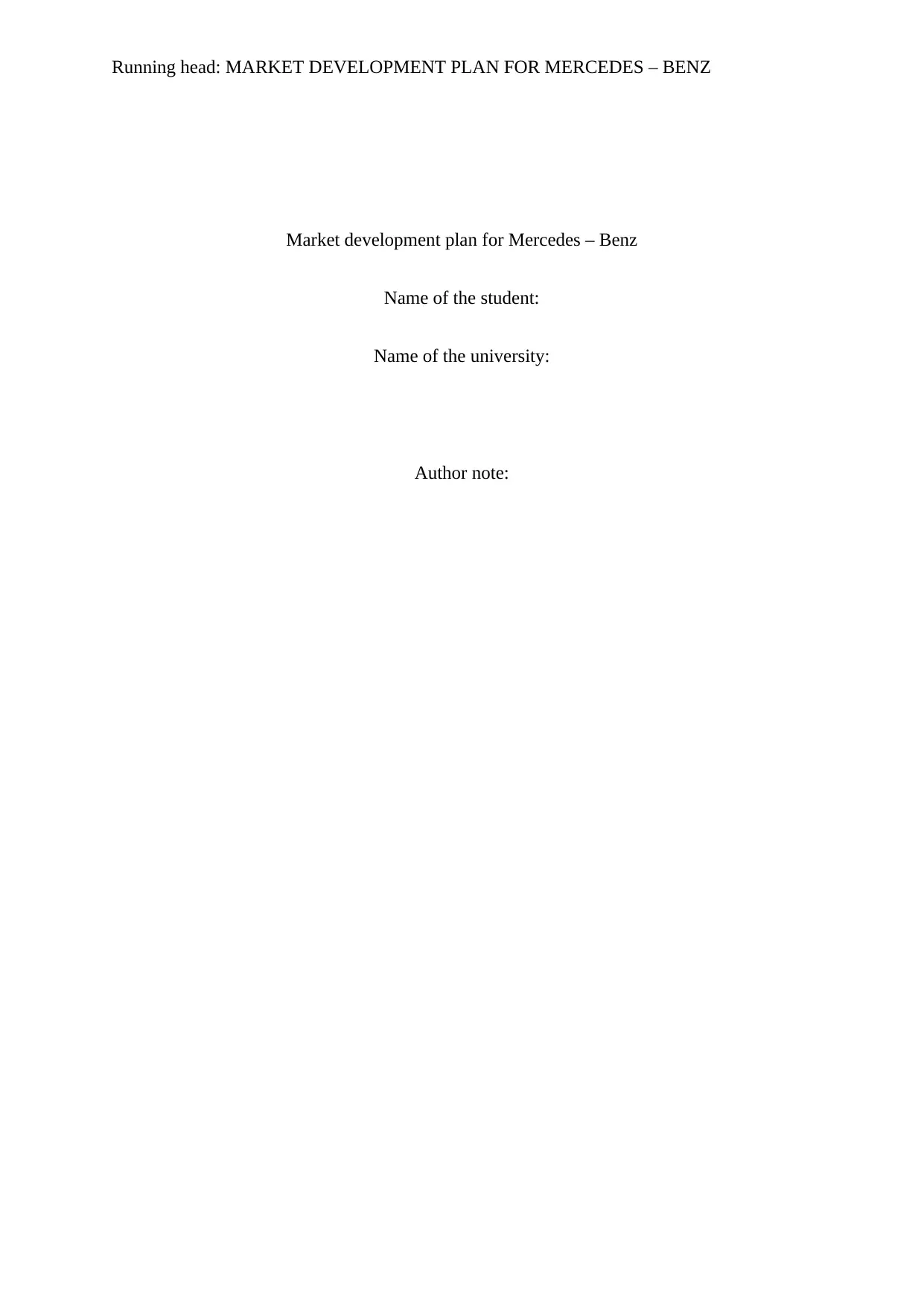
Running head: MARKET DEVELOPMENT PLAN FOR MERCEDES – BENZ
Market development plan for Mercedes – Benz
Name of the student:
Name of the university:
Author note:
Market development plan for Mercedes – Benz
Name of the student:
Name of the university:
Author note:
Paraphrase This Document
Need a fresh take? Get an instant paraphrase of this document with our AI Paraphraser
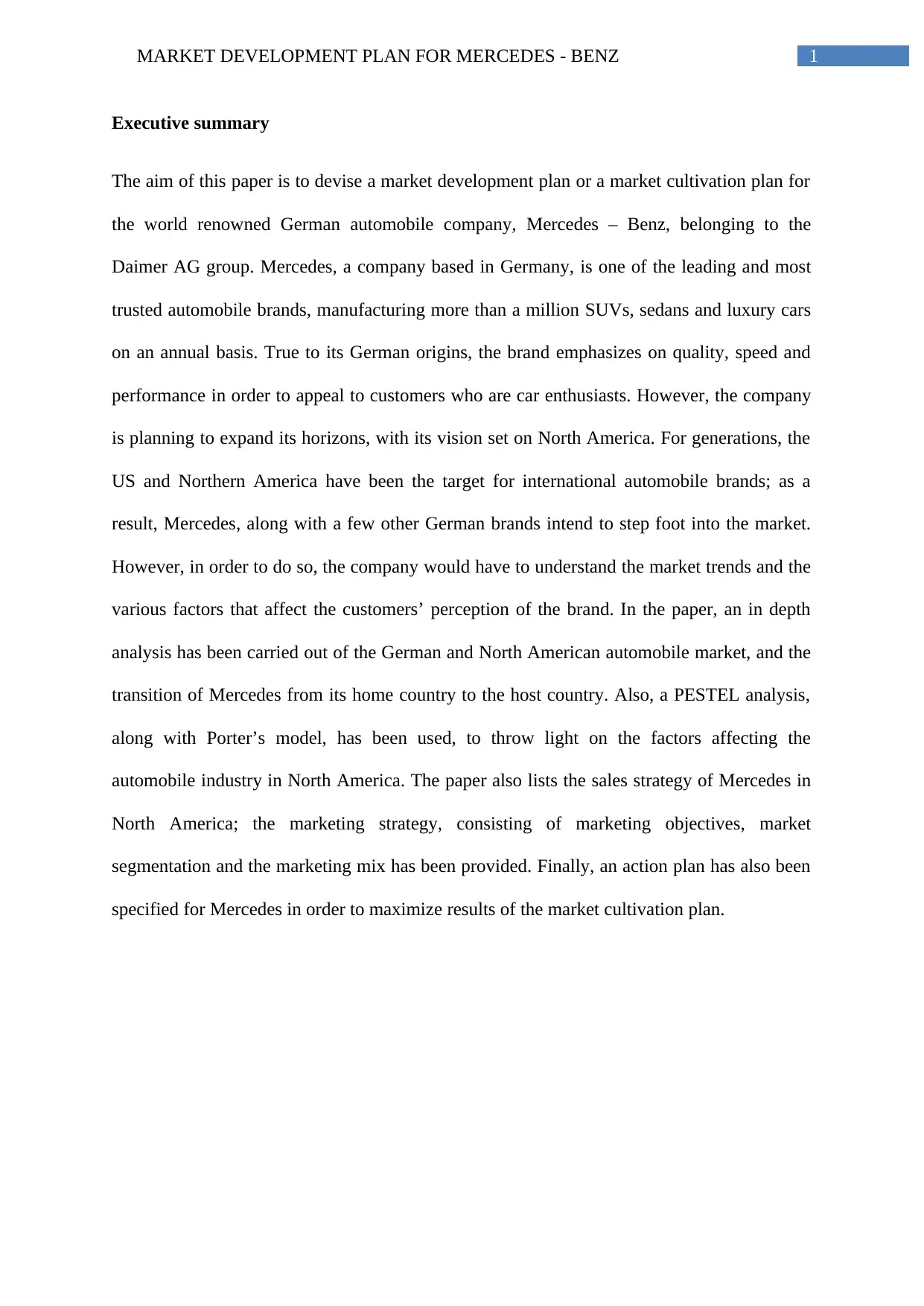
1MARKET DEVELOPMENT PLAN FOR MERCEDES - BENZ
Executive summary
The aim of this paper is to devise a market development plan or a market cultivation plan for
the world renowned German automobile company, Mercedes – Benz, belonging to the
Daimer AG group. Mercedes, a company based in Germany, is one of the leading and most
trusted automobile brands, manufacturing more than a million SUVs, sedans and luxury cars
on an annual basis. True to its German origins, the brand emphasizes on quality, speed and
performance in order to appeal to customers who are car enthusiasts. However, the company
is planning to expand its horizons, with its vision set on North America. For generations, the
US and Northern America have been the target for international automobile brands; as a
result, Mercedes, along with a few other German brands intend to step foot into the market.
However, in order to do so, the company would have to understand the market trends and the
various factors that affect the customers’ perception of the brand. In the paper, an in depth
analysis has been carried out of the German and North American automobile market, and the
transition of Mercedes from its home country to the host country. Also, a PESTEL analysis,
along with Porter’s model, has been used, to throw light on the factors affecting the
automobile industry in North America. The paper also lists the sales strategy of Mercedes in
North America; the marketing strategy, consisting of marketing objectives, market
segmentation and the marketing mix has been provided. Finally, an action plan has also been
specified for Mercedes in order to maximize results of the market cultivation plan.
Executive summary
The aim of this paper is to devise a market development plan or a market cultivation plan for
the world renowned German automobile company, Mercedes – Benz, belonging to the
Daimer AG group. Mercedes, a company based in Germany, is one of the leading and most
trusted automobile brands, manufacturing more than a million SUVs, sedans and luxury cars
on an annual basis. True to its German origins, the brand emphasizes on quality, speed and
performance in order to appeal to customers who are car enthusiasts. However, the company
is planning to expand its horizons, with its vision set on North America. For generations, the
US and Northern America have been the target for international automobile brands; as a
result, Mercedes, along with a few other German brands intend to step foot into the market.
However, in order to do so, the company would have to understand the market trends and the
various factors that affect the customers’ perception of the brand. In the paper, an in depth
analysis has been carried out of the German and North American automobile market, and the
transition of Mercedes from its home country to the host country. Also, a PESTEL analysis,
along with Porter’s model, has been used, to throw light on the factors affecting the
automobile industry in North America. The paper also lists the sales strategy of Mercedes in
North America; the marketing strategy, consisting of marketing objectives, market
segmentation and the marketing mix has been provided. Finally, an action plan has also been
specified for Mercedes in order to maximize results of the market cultivation plan.
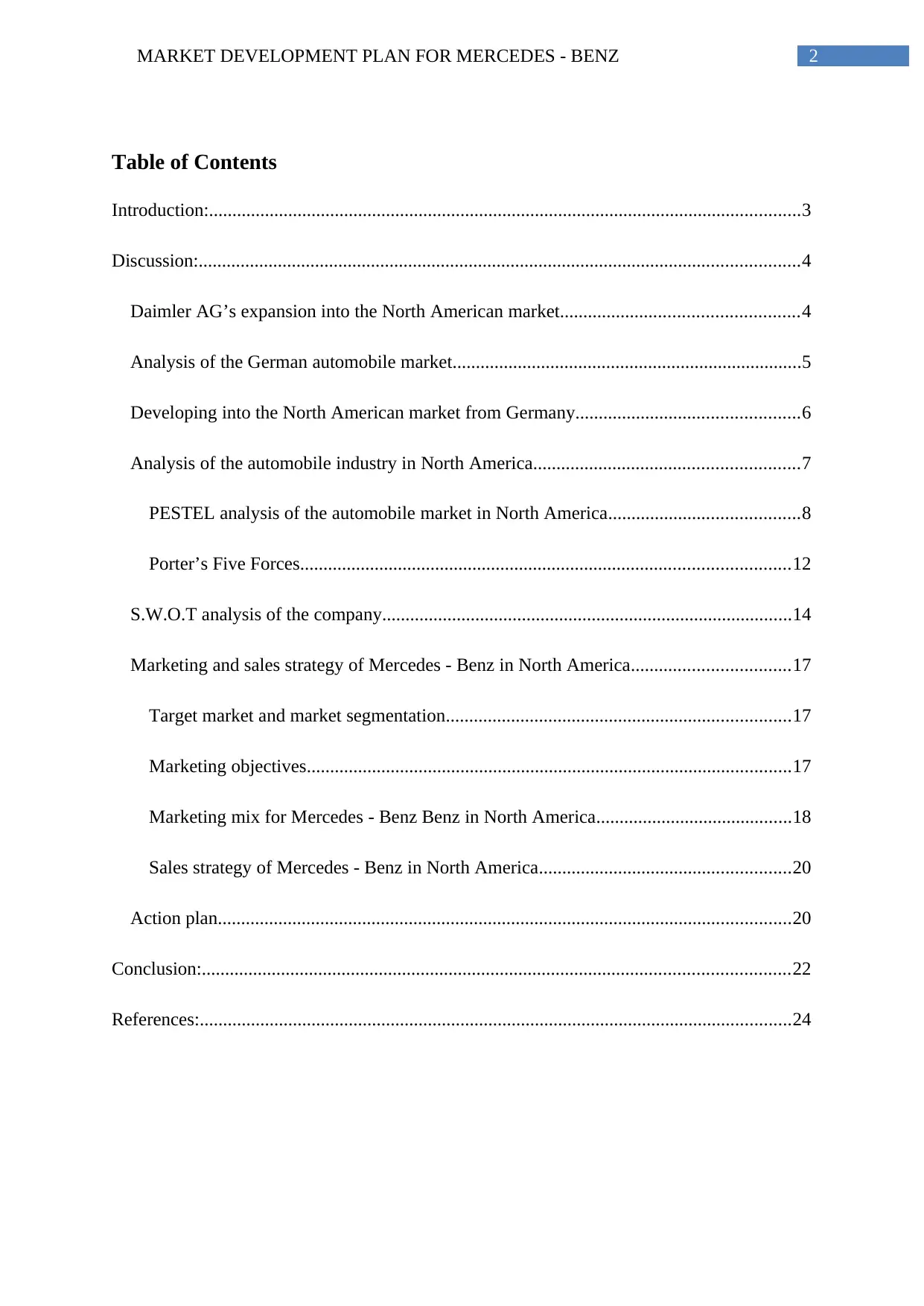
2MARKET DEVELOPMENT PLAN FOR MERCEDES - BENZ
Table of Contents
Introduction:...............................................................................................................................3
Discussion:.................................................................................................................................4
Daimler AG’s expansion into the North American market...................................................4
Analysis of the German automobile market...........................................................................5
Developing into the North American market from Germany................................................6
Analysis of the automobile industry in North America.........................................................7
PESTEL analysis of the automobile market in North America.........................................8
Porter’s Five Forces.........................................................................................................12
S.W.O.T analysis of the company........................................................................................14
Marketing and sales strategy of Mercedes - Benz in North America..................................17
Target market and market segmentation..........................................................................17
Marketing objectives........................................................................................................17
Marketing mix for Mercedes - Benz Benz in North America..........................................18
Sales strategy of Mercedes - Benz in North America......................................................20
Action plan...........................................................................................................................20
Conclusion:..............................................................................................................................22
References:...............................................................................................................................24
Table of Contents
Introduction:...............................................................................................................................3
Discussion:.................................................................................................................................4
Daimler AG’s expansion into the North American market...................................................4
Analysis of the German automobile market...........................................................................5
Developing into the North American market from Germany................................................6
Analysis of the automobile industry in North America.........................................................7
PESTEL analysis of the automobile market in North America.........................................8
Porter’s Five Forces.........................................................................................................12
S.W.O.T analysis of the company........................................................................................14
Marketing and sales strategy of Mercedes - Benz in North America..................................17
Target market and market segmentation..........................................................................17
Marketing objectives........................................................................................................17
Marketing mix for Mercedes - Benz Benz in North America..........................................18
Sales strategy of Mercedes - Benz in North America......................................................20
Action plan...........................................................................................................................20
Conclusion:..............................................................................................................................22
References:...............................................................................................................................24
⊘ This is a preview!⊘
Do you want full access?
Subscribe today to unlock all pages.

Trusted by 1+ million students worldwide

3MARKET DEVELOPMENT PLAN FOR MERCEDES - BENZ
Paraphrase This Document
Need a fresh take? Get an instant paraphrase of this document with our AI Paraphraser
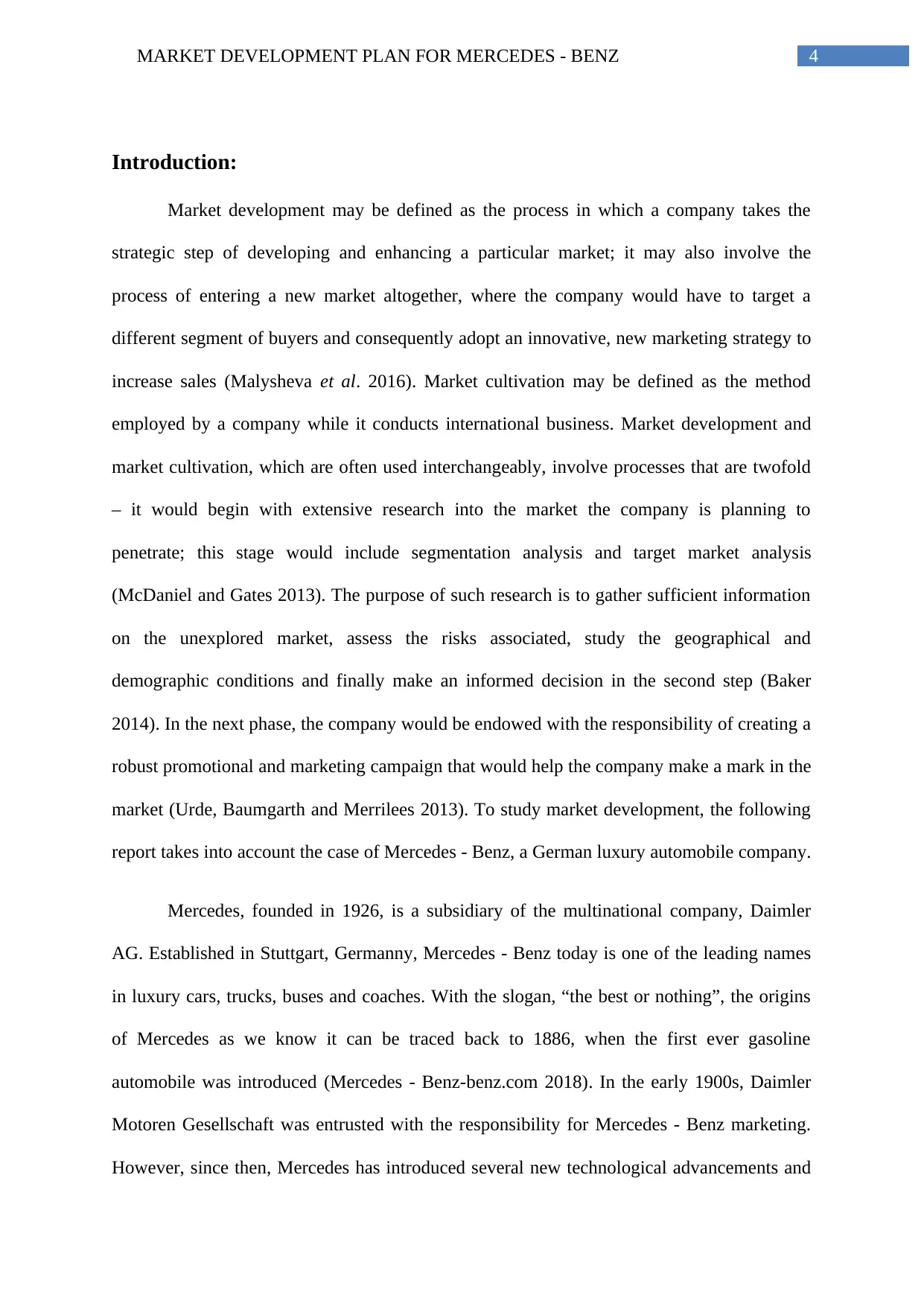
4MARKET DEVELOPMENT PLAN FOR MERCEDES - BENZ
Introduction:
Market development may be defined as the process in which a company takes the
strategic step of developing and enhancing a particular market; it may also involve the
process of entering a new market altogether, where the company would have to target a
different segment of buyers and consequently adopt an innovative, new marketing strategy to
increase sales (Malysheva et al. 2016). Market cultivation may be defined as the method
employed by a company while it conducts international business. Market development and
market cultivation, which are often used interchangeably, involve processes that are twofold
– it would begin with extensive research into the market the company is planning to
penetrate; this stage would include segmentation analysis and target market analysis
(McDaniel and Gates 2013). The purpose of such research is to gather sufficient information
on the unexplored market, assess the risks associated, study the geographical and
demographic conditions and finally make an informed decision in the second step (Baker
2014). In the next phase, the company would be endowed with the responsibility of creating a
robust promotional and marketing campaign that would help the company make a mark in the
market (Urde, Baumgarth and Merrilees 2013). To study market development, the following
report takes into account the case of Mercedes - Benz, a German luxury automobile company.
Mercedes, founded in 1926, is a subsidiary of the multinational company, Daimler
AG. Established in Stuttgart, Germanny, Mercedes - Benz today is one of the leading names
in luxury cars, trucks, buses and coaches. With the slogan, “the best or nothing”, the origins
of Mercedes as we know it can be traced back to 1886, when the first ever gasoline
automobile was introduced (Mercedes - Benz-benz.com 2018). In the early 1900s, Daimler
Motoren Gesellschaft was entrusted with the responsibility for Mercedes - Benz marketing.
However, since then, Mercedes has introduced several new technological advancements and
Introduction:
Market development may be defined as the process in which a company takes the
strategic step of developing and enhancing a particular market; it may also involve the
process of entering a new market altogether, where the company would have to target a
different segment of buyers and consequently adopt an innovative, new marketing strategy to
increase sales (Malysheva et al. 2016). Market cultivation may be defined as the method
employed by a company while it conducts international business. Market development and
market cultivation, which are often used interchangeably, involve processes that are twofold
– it would begin with extensive research into the market the company is planning to
penetrate; this stage would include segmentation analysis and target market analysis
(McDaniel and Gates 2013). The purpose of such research is to gather sufficient information
on the unexplored market, assess the risks associated, study the geographical and
demographic conditions and finally make an informed decision in the second step (Baker
2014). In the next phase, the company would be endowed with the responsibility of creating a
robust promotional and marketing campaign that would help the company make a mark in the
market (Urde, Baumgarth and Merrilees 2013). To study market development, the following
report takes into account the case of Mercedes - Benz, a German luxury automobile company.
Mercedes, founded in 1926, is a subsidiary of the multinational company, Daimler
AG. Established in Stuttgart, Germanny, Mercedes - Benz today is one of the leading names
in luxury cars, trucks, buses and coaches. With the slogan, “the best or nothing”, the origins
of Mercedes as we know it can be traced back to 1886, when the first ever gasoline
automobile was introduced (Mercedes - Benz-benz.com 2018). In the early 1900s, Daimler
Motoren Gesellschaft was entrusted with the responsibility for Mercedes - Benz marketing.
However, since then, Mercedes has introduced several new technological advancements and
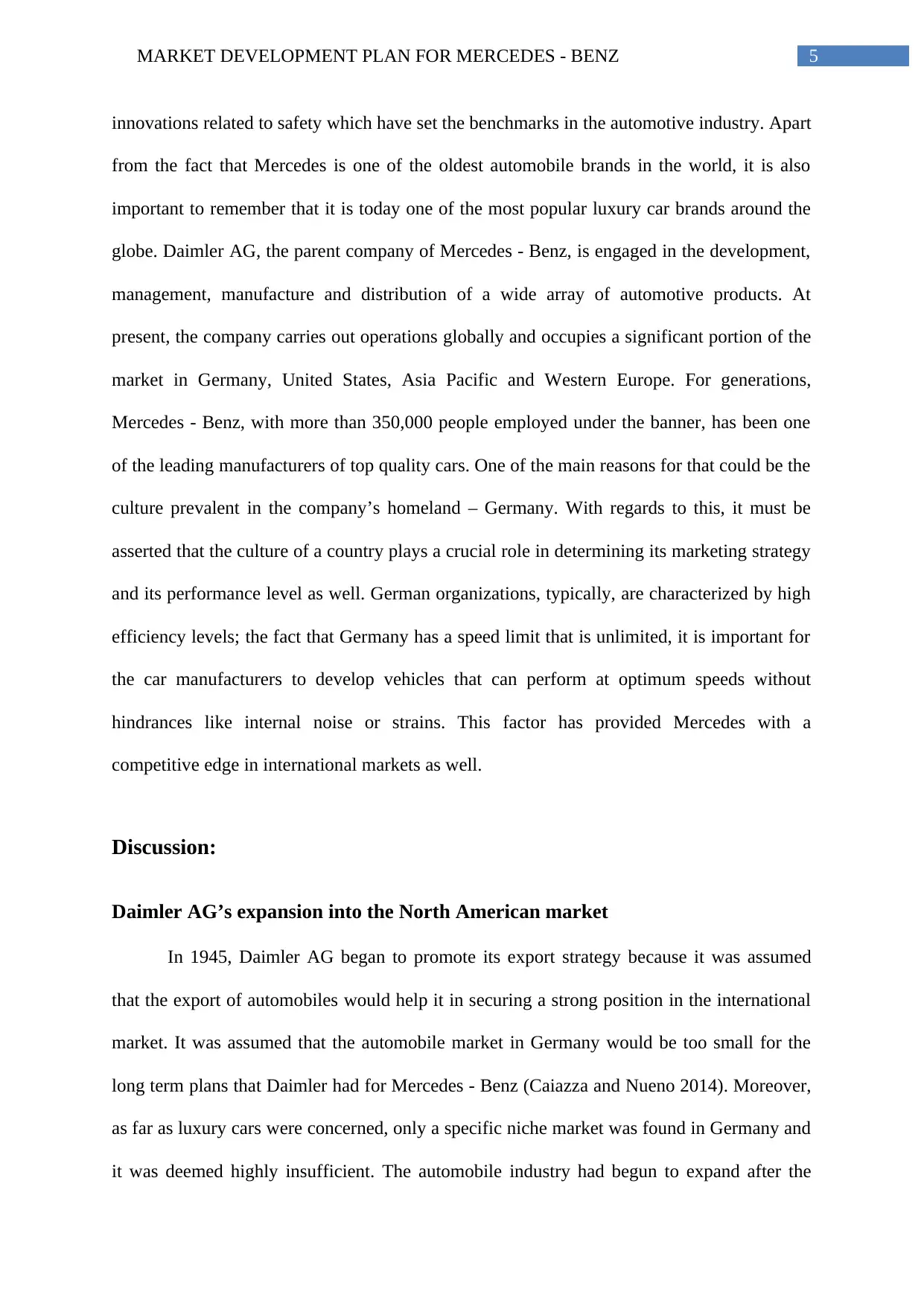
5MARKET DEVELOPMENT PLAN FOR MERCEDES - BENZ
innovations related to safety which have set the benchmarks in the automotive industry. Apart
from the fact that Mercedes is one of the oldest automobile brands in the world, it is also
important to remember that it is today one of the most popular luxury car brands around the
globe. Daimler AG, the parent company of Mercedes - Benz, is engaged in the development,
management, manufacture and distribution of a wide array of automotive products. At
present, the company carries out operations globally and occupies a significant portion of the
market in Germany, United States, Asia Pacific and Western Europe. For generations,
Mercedes - Benz, with more than 350,000 people employed under the banner, has been one
of the leading manufacturers of top quality cars. One of the main reasons for that could be the
culture prevalent in the company’s homeland – Germany. With regards to this, it must be
asserted that the culture of a country plays a crucial role in determining its marketing strategy
and its performance level as well. German organizations, typically, are characterized by high
efficiency levels; the fact that Germany has a speed limit that is unlimited, it is important for
the car manufacturers to develop vehicles that can perform at optimum speeds without
hindrances like internal noise or strains. This factor has provided Mercedes with a
competitive edge in international markets as well.
Discussion:
Daimler AG’s expansion into the North American market
In 1945, Daimler AG began to promote its export strategy because it was assumed
that the export of automobiles would help it in securing a strong position in the international
market. It was assumed that the automobile market in Germany would be too small for the
long term plans that Daimler had for Mercedes - Benz (Caiazza and Nueno 2014). Moreover,
as far as luxury cars were concerned, only a specific niche market was found in Germany and
it was deemed highly insufficient. The automobile industry had begun to expand after the
innovations related to safety which have set the benchmarks in the automotive industry. Apart
from the fact that Mercedes is one of the oldest automobile brands in the world, it is also
important to remember that it is today one of the most popular luxury car brands around the
globe. Daimler AG, the parent company of Mercedes - Benz, is engaged in the development,
management, manufacture and distribution of a wide array of automotive products. At
present, the company carries out operations globally and occupies a significant portion of the
market in Germany, United States, Asia Pacific and Western Europe. For generations,
Mercedes - Benz, with more than 350,000 people employed under the banner, has been one
of the leading manufacturers of top quality cars. One of the main reasons for that could be the
culture prevalent in the company’s homeland – Germany. With regards to this, it must be
asserted that the culture of a country plays a crucial role in determining its marketing strategy
and its performance level as well. German organizations, typically, are characterized by high
efficiency levels; the fact that Germany has a speed limit that is unlimited, it is important for
the car manufacturers to develop vehicles that can perform at optimum speeds without
hindrances like internal noise or strains. This factor has provided Mercedes with a
competitive edge in international markets as well.
Discussion:
Daimler AG’s expansion into the North American market
In 1945, Daimler AG began to promote its export strategy because it was assumed
that the export of automobiles would help it in securing a strong position in the international
market. It was assumed that the automobile market in Germany would be too small for the
long term plans that Daimler had for Mercedes - Benz (Caiazza and Nueno 2014). Moreover,
as far as luxury cars were concerned, only a specific niche market was found in Germany and
it was deemed highly insufficient. The automobile industry had begun to expand after the
⊘ This is a preview!⊘
Do you want full access?
Subscribe today to unlock all pages.

Trusted by 1+ million students worldwide
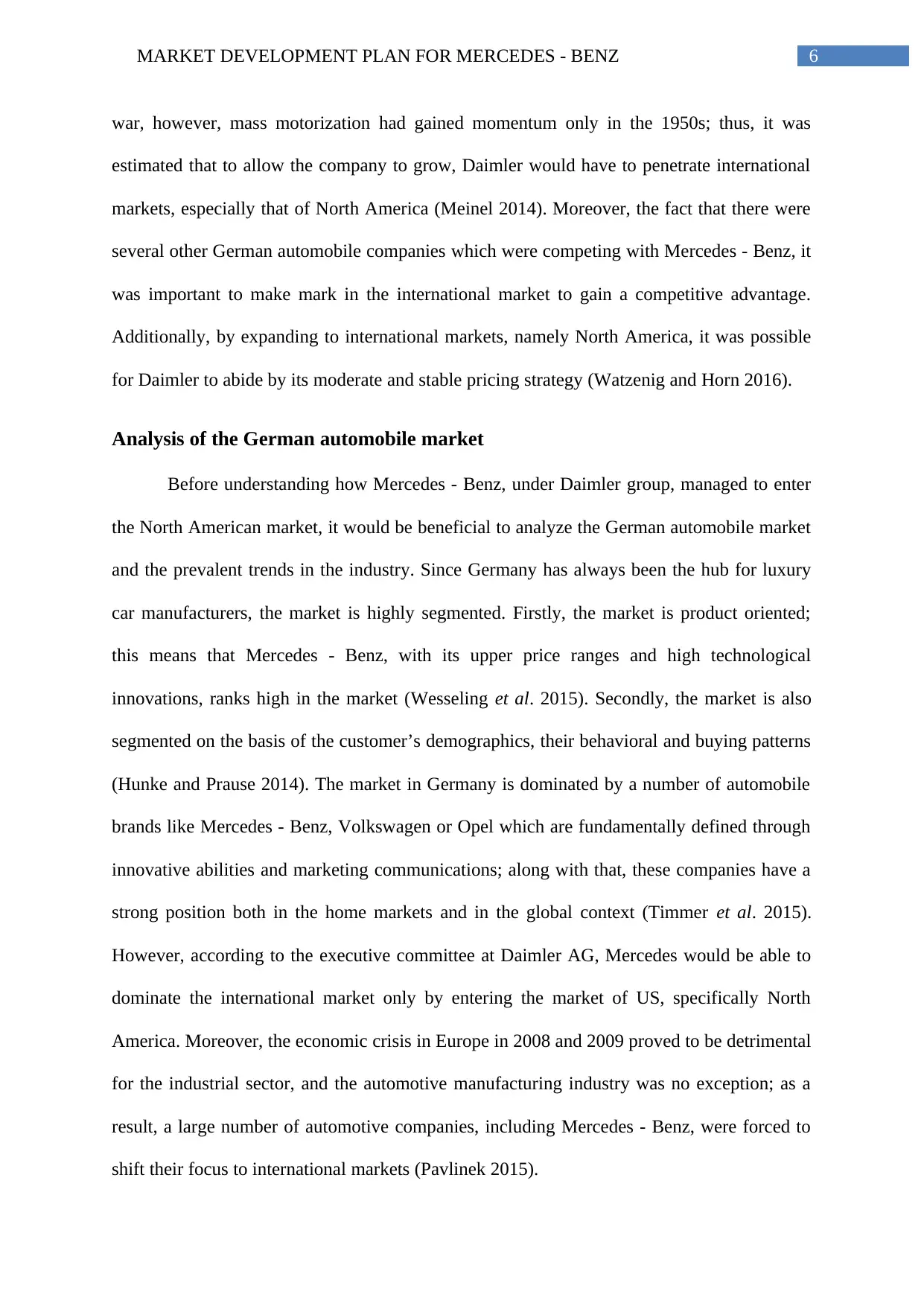
6MARKET DEVELOPMENT PLAN FOR MERCEDES - BENZ
war, however, mass motorization had gained momentum only in the 1950s; thus, it was
estimated that to allow the company to grow, Daimler would have to penetrate international
markets, especially that of North America (Meinel 2014). Moreover, the fact that there were
several other German automobile companies which were competing with Mercedes - Benz, it
was important to make mark in the international market to gain a competitive advantage.
Additionally, by expanding to international markets, namely North America, it was possible
for Daimler to abide by its moderate and stable pricing strategy (Watzenig and Horn 2016).
Analysis of the German automobile market
Before understanding how Mercedes - Benz, under Daimler group, managed to enter
the North American market, it would be beneficial to analyze the German automobile market
and the prevalent trends in the industry. Since Germany has always been the hub for luxury
car manufacturers, the market is highly segmented. Firstly, the market is product oriented;
this means that Mercedes - Benz, with its upper price ranges and high technological
innovations, ranks high in the market (Wesseling et al. 2015). Secondly, the market is also
segmented on the basis of the customer’s demographics, their behavioral and buying patterns
(Hunke and Prause 2014). The market in Germany is dominated by a number of automobile
brands like Mercedes - Benz, Volkswagen or Opel which are fundamentally defined through
innovative abilities and marketing communications; along with that, these companies have a
strong position both in the home markets and in the global context (Timmer et al. 2015).
However, according to the executive committee at Daimler AG, Mercedes would be able to
dominate the international market only by entering the market of US, specifically North
America. Moreover, the economic crisis in Europe in 2008 and 2009 proved to be detrimental
for the industrial sector, and the automotive manufacturing industry was no exception; as a
result, a large number of automotive companies, including Mercedes - Benz, were forced to
shift their focus to international markets (Pavlinek 2015).
war, however, mass motorization had gained momentum only in the 1950s; thus, it was
estimated that to allow the company to grow, Daimler would have to penetrate international
markets, especially that of North America (Meinel 2014). Moreover, the fact that there were
several other German automobile companies which were competing with Mercedes - Benz, it
was important to make mark in the international market to gain a competitive advantage.
Additionally, by expanding to international markets, namely North America, it was possible
for Daimler to abide by its moderate and stable pricing strategy (Watzenig and Horn 2016).
Analysis of the German automobile market
Before understanding how Mercedes - Benz, under Daimler group, managed to enter
the North American market, it would be beneficial to analyze the German automobile market
and the prevalent trends in the industry. Since Germany has always been the hub for luxury
car manufacturers, the market is highly segmented. Firstly, the market is product oriented;
this means that Mercedes - Benz, with its upper price ranges and high technological
innovations, ranks high in the market (Wesseling et al. 2015). Secondly, the market is also
segmented on the basis of the customer’s demographics, their behavioral and buying patterns
(Hunke and Prause 2014). The market in Germany is dominated by a number of automobile
brands like Mercedes - Benz, Volkswagen or Opel which are fundamentally defined through
innovative abilities and marketing communications; along with that, these companies have a
strong position both in the home markets and in the global context (Timmer et al. 2015).
However, according to the executive committee at Daimler AG, Mercedes would be able to
dominate the international market only by entering the market of US, specifically North
America. Moreover, the economic crisis in Europe in 2008 and 2009 proved to be detrimental
for the industrial sector, and the automotive manufacturing industry was no exception; as a
result, a large number of automotive companies, including Mercedes - Benz, were forced to
shift their focus to international markets (Pavlinek 2015).
Paraphrase This Document
Need a fresh take? Get an instant paraphrase of this document with our AI Paraphraser
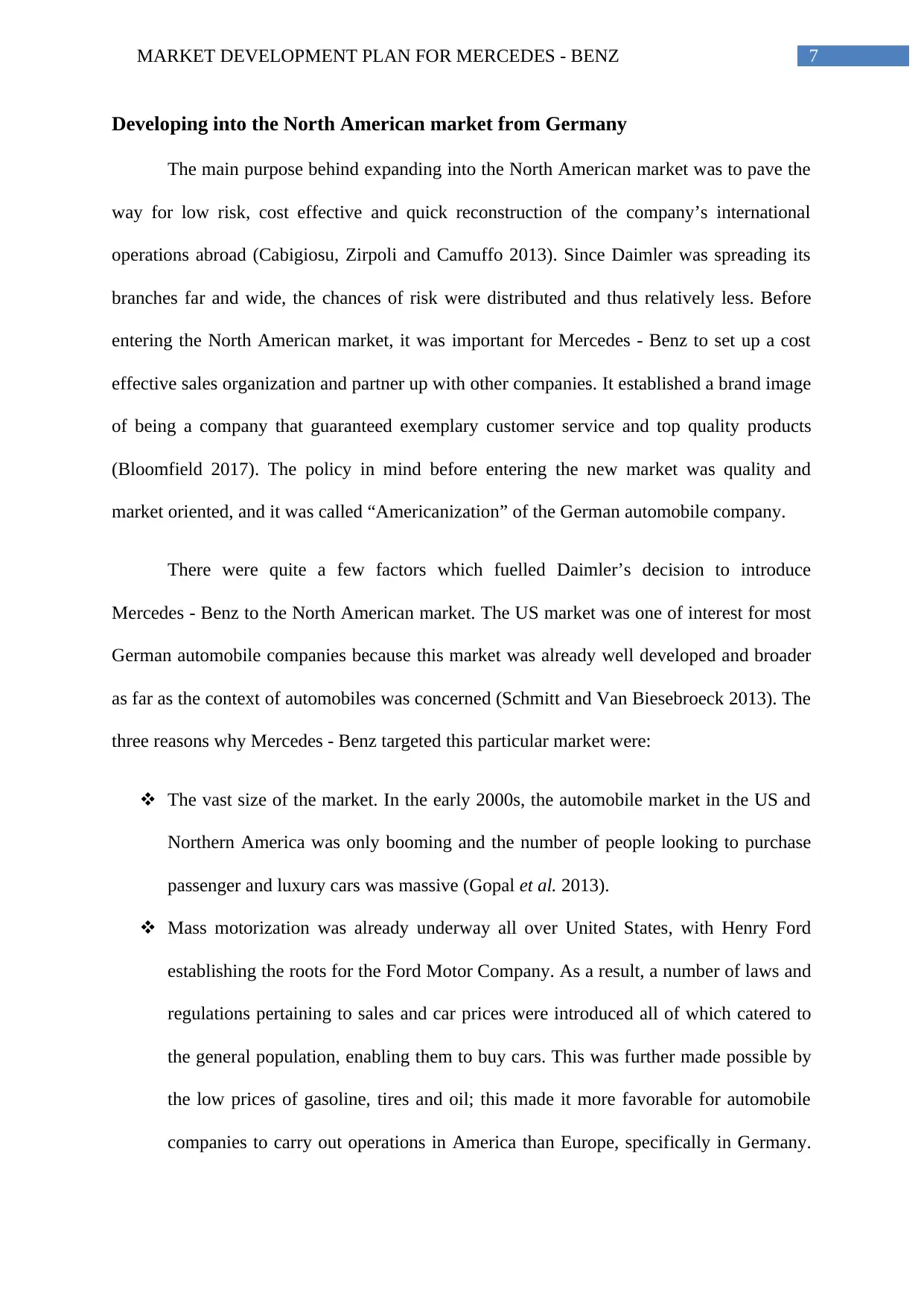
7MARKET DEVELOPMENT PLAN FOR MERCEDES - BENZ
Developing into the North American market from Germany
The main purpose behind expanding into the North American market was to pave the
way for low risk, cost effective and quick reconstruction of the company’s international
operations abroad (Cabigiosu, Zirpoli and Camuffo 2013). Since Daimler was spreading its
branches far and wide, the chances of risk were distributed and thus relatively less. Before
entering the North American market, it was important for Mercedes - Benz to set up a cost
effective sales organization and partner up with other companies. It established a brand image
of being a company that guaranteed exemplary customer service and top quality products
(Bloomfield 2017). The policy in mind before entering the new market was quality and
market oriented, and it was called “Americanization” of the German automobile company.
There were quite a few factors which fuelled Daimler’s decision to introduce
Mercedes - Benz to the North American market. The US market was one of interest for most
German automobile companies because this market was already well developed and broader
as far as the context of automobiles was concerned (Schmitt and Van Biesebroeck 2013). The
three reasons why Mercedes - Benz targeted this particular market were:
The vast size of the market. In the early 2000s, the automobile market in the US and
Northern America was only booming and the number of people looking to purchase
passenger and luxury cars was massive (Gopal et al. 2013).
Mass motorization was already underway all over United States, with Henry Ford
establishing the roots for the Ford Motor Company. As a result, a number of laws and
regulations pertaining to sales and car prices were introduced all of which catered to
the general population, enabling them to buy cars. This was further made possible by
the low prices of gasoline, tires and oil; this made it more favorable for automobile
companies to carry out operations in America than Europe, specifically in Germany.
Developing into the North American market from Germany
The main purpose behind expanding into the North American market was to pave the
way for low risk, cost effective and quick reconstruction of the company’s international
operations abroad (Cabigiosu, Zirpoli and Camuffo 2013). Since Daimler was spreading its
branches far and wide, the chances of risk were distributed and thus relatively less. Before
entering the North American market, it was important for Mercedes - Benz to set up a cost
effective sales organization and partner up with other companies. It established a brand image
of being a company that guaranteed exemplary customer service and top quality products
(Bloomfield 2017). The policy in mind before entering the new market was quality and
market oriented, and it was called “Americanization” of the German automobile company.
There were quite a few factors which fuelled Daimler’s decision to introduce
Mercedes - Benz to the North American market. The US market was one of interest for most
German automobile companies because this market was already well developed and broader
as far as the context of automobiles was concerned (Schmitt and Van Biesebroeck 2013). The
three reasons why Mercedes - Benz targeted this particular market were:
The vast size of the market. In the early 2000s, the automobile market in the US and
Northern America was only booming and the number of people looking to purchase
passenger and luxury cars was massive (Gopal et al. 2013).
Mass motorization was already underway all over United States, with Henry Ford
establishing the roots for the Ford Motor Company. As a result, a number of laws and
regulations pertaining to sales and car prices were introduced all of which catered to
the general population, enabling them to buy cars. This was further made possible by
the low prices of gasoline, tires and oil; this made it more favorable for automobile
companies to carry out operations in America than Europe, specifically in Germany.
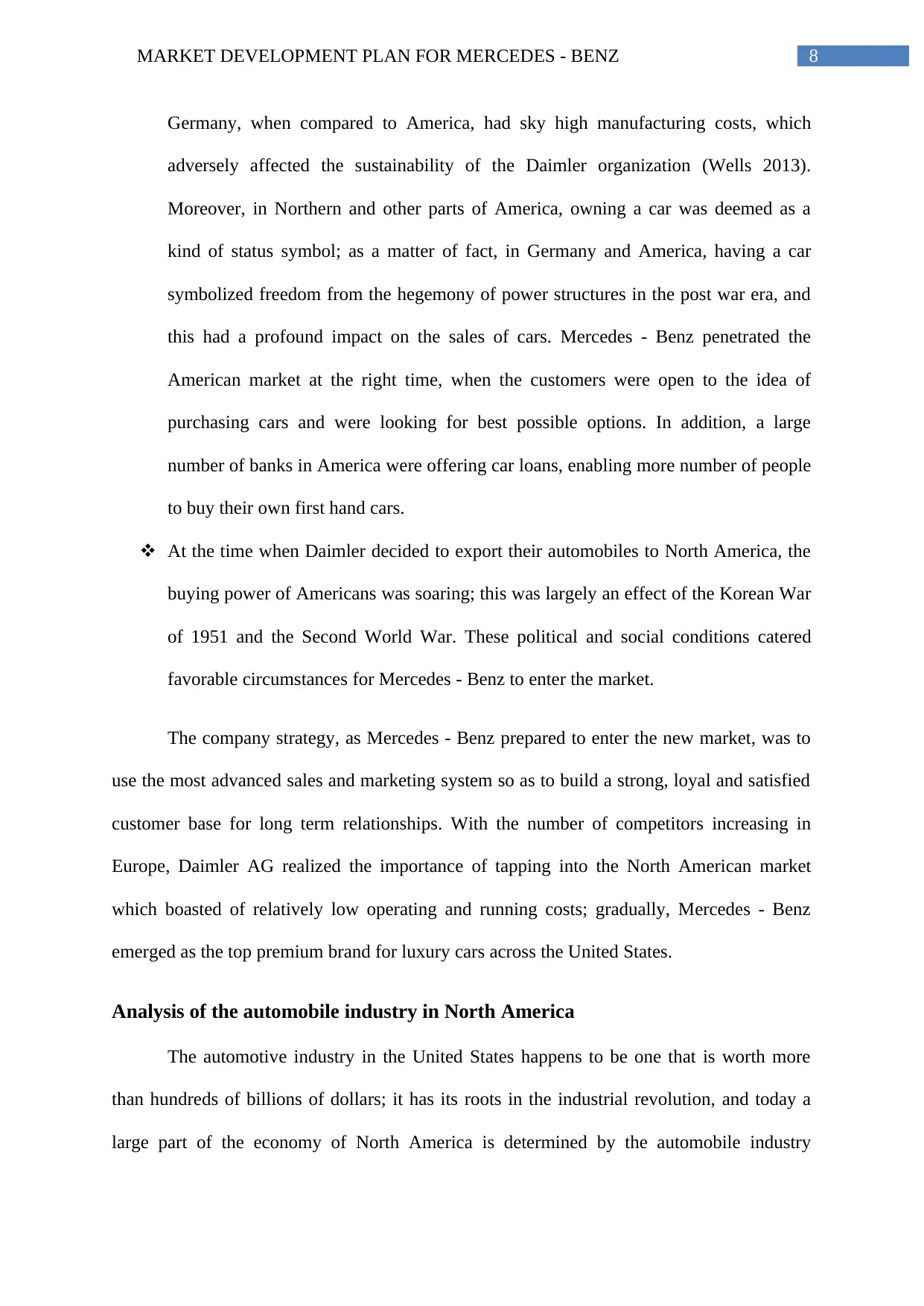
8MARKET DEVELOPMENT PLAN FOR MERCEDES - BENZ
Germany, when compared to America, had sky high manufacturing costs, which
adversely affected the sustainability of the Daimler organization (Wells 2013).
Moreover, in Northern and other parts of America, owning a car was deemed as a
kind of status symbol; as a matter of fact, in Germany and America, having a car
symbolized freedom from the hegemony of power structures in the post war era, and
this had a profound impact on the sales of cars. Mercedes - Benz penetrated the
American market at the right time, when the customers were open to the idea of
purchasing cars and were looking for best possible options. In addition, a large
number of banks in America were offering car loans, enabling more number of people
to buy their own first hand cars.
At the time when Daimler decided to export their automobiles to North America, the
buying power of Americans was soaring; this was largely an effect of the Korean War
of 1951 and the Second World War. These political and social conditions catered
favorable circumstances for Mercedes - Benz to enter the market.
The company strategy, as Mercedes - Benz prepared to enter the new market, was to
use the most advanced sales and marketing system so as to build a strong, loyal and satisfied
customer base for long term relationships. With the number of competitors increasing in
Europe, Daimler AG realized the importance of tapping into the North American market
which boasted of relatively low operating and running costs; gradually, Mercedes - Benz
emerged as the top premium brand for luxury cars across the United States.
Analysis of the automobile industry in North America
The automotive industry in the United States happens to be one that is worth more
than hundreds of billions of dollars; it has its roots in the industrial revolution, and today a
large part of the economy of North America is determined by the automobile industry
Germany, when compared to America, had sky high manufacturing costs, which
adversely affected the sustainability of the Daimler organization (Wells 2013).
Moreover, in Northern and other parts of America, owning a car was deemed as a
kind of status symbol; as a matter of fact, in Germany and America, having a car
symbolized freedom from the hegemony of power structures in the post war era, and
this had a profound impact on the sales of cars. Mercedes - Benz penetrated the
American market at the right time, when the customers were open to the idea of
purchasing cars and were looking for best possible options. In addition, a large
number of banks in America were offering car loans, enabling more number of people
to buy their own first hand cars.
At the time when Daimler decided to export their automobiles to North America, the
buying power of Americans was soaring; this was largely an effect of the Korean War
of 1951 and the Second World War. These political and social conditions catered
favorable circumstances for Mercedes - Benz to enter the market.
The company strategy, as Mercedes - Benz prepared to enter the new market, was to
use the most advanced sales and marketing system so as to build a strong, loyal and satisfied
customer base for long term relationships. With the number of competitors increasing in
Europe, Daimler AG realized the importance of tapping into the North American market
which boasted of relatively low operating and running costs; gradually, Mercedes - Benz
emerged as the top premium brand for luxury cars across the United States.
Analysis of the automobile industry in North America
The automotive industry in the United States happens to be one that is worth more
than hundreds of billions of dollars; it has its roots in the industrial revolution, and today a
large part of the economy of North America is determined by the automobile industry
⊘ This is a preview!⊘
Do you want full access?
Subscribe today to unlock all pages.

Trusted by 1+ million students worldwide
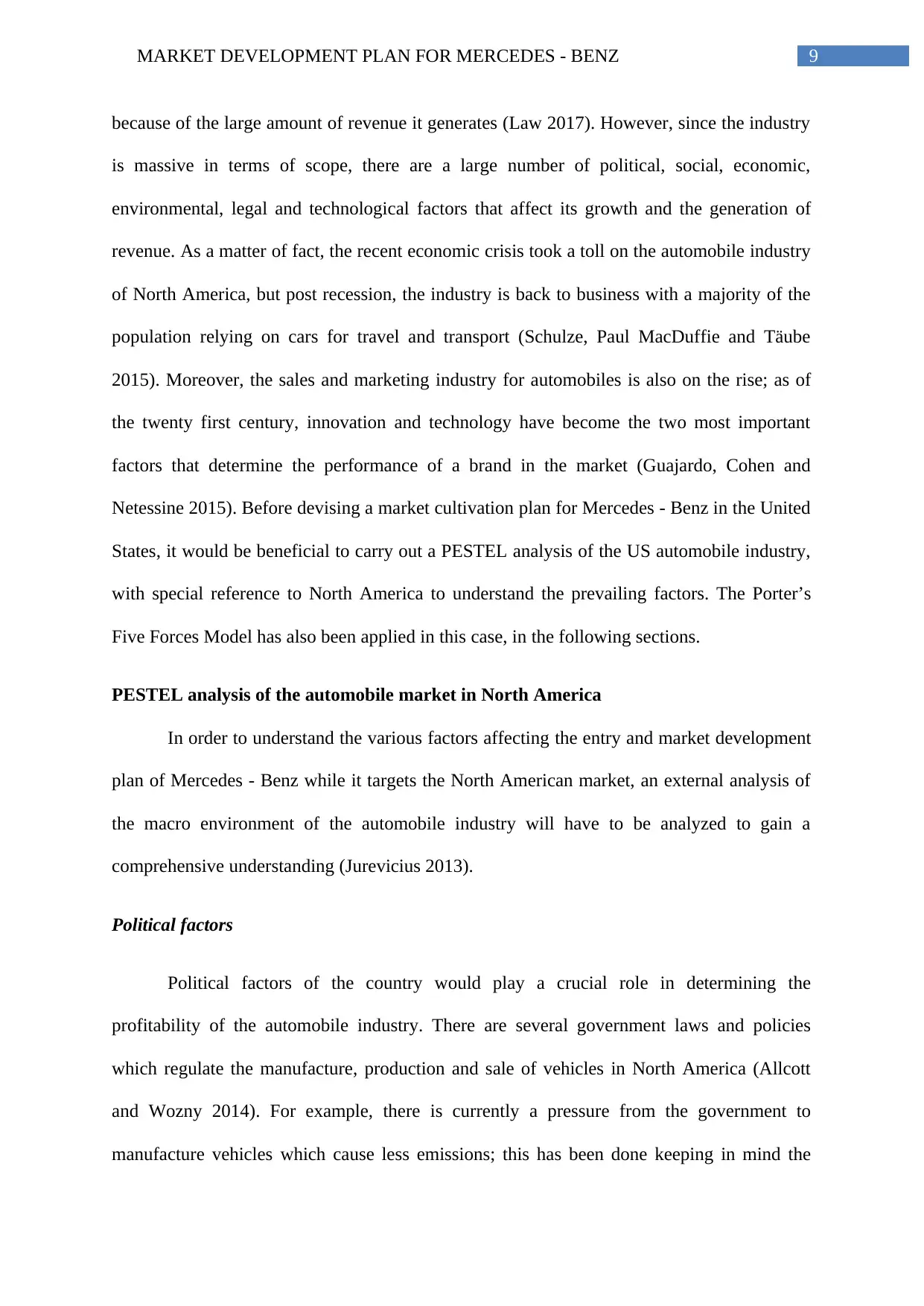
9MARKET DEVELOPMENT PLAN FOR MERCEDES - BENZ
because of the large amount of revenue it generates (Law 2017). However, since the industry
is massive in terms of scope, there are a large number of political, social, economic,
environmental, legal and technological factors that affect its growth and the generation of
revenue. As a matter of fact, the recent economic crisis took a toll on the automobile industry
of North America, but post recession, the industry is back to business with a majority of the
population relying on cars for travel and transport (Schulze, Paul MacDuffie and Täube
2015). Moreover, the sales and marketing industry for automobiles is also on the rise; as of
the twenty first century, innovation and technology have become the two most important
factors that determine the performance of a brand in the market (Guajardo, Cohen and
Netessine 2015). Before devising a market cultivation plan for Mercedes - Benz in the United
States, it would be beneficial to carry out a PESTEL analysis of the US automobile industry,
with special reference to North America to understand the prevailing factors. The Porter’s
Five Forces Model has also been applied in this case, in the following sections.
PESTEL analysis of the automobile market in North America
In order to understand the various factors affecting the entry and market development
plan of Mercedes - Benz while it targets the North American market, an external analysis of
the macro environment of the automobile industry will have to be analyzed to gain a
comprehensive understanding (Jurevicius 2013).
Political factors
Political factors of the country would play a crucial role in determining the
profitability of the automobile industry. There are several government laws and policies
which regulate the manufacture, production and sale of vehicles in North America (Allcott
and Wozny 2014). For example, there is currently a pressure from the government to
manufacture vehicles which cause less emissions; this has been done keeping in mind the
because of the large amount of revenue it generates (Law 2017). However, since the industry
is massive in terms of scope, there are a large number of political, social, economic,
environmental, legal and technological factors that affect its growth and the generation of
revenue. As a matter of fact, the recent economic crisis took a toll on the automobile industry
of North America, but post recession, the industry is back to business with a majority of the
population relying on cars for travel and transport (Schulze, Paul MacDuffie and Täube
2015). Moreover, the sales and marketing industry for automobiles is also on the rise; as of
the twenty first century, innovation and technology have become the two most important
factors that determine the performance of a brand in the market (Guajardo, Cohen and
Netessine 2015). Before devising a market cultivation plan for Mercedes - Benz in the United
States, it would be beneficial to carry out a PESTEL analysis of the US automobile industry,
with special reference to North America to understand the prevailing factors. The Porter’s
Five Forces Model has also been applied in this case, in the following sections.
PESTEL analysis of the automobile market in North America
In order to understand the various factors affecting the entry and market development
plan of Mercedes - Benz while it targets the North American market, an external analysis of
the macro environment of the automobile industry will have to be analyzed to gain a
comprehensive understanding (Jurevicius 2013).
Political factors
Political factors of the country would play a crucial role in determining the
profitability of the automobile industry. There are several government laws and policies
which regulate the manufacture, production and sale of vehicles in North America (Allcott
and Wozny 2014). For example, there is currently a pressure from the government to
manufacture vehicles which cause less emissions; this has been done keeping in mind the
Paraphrase This Document
Need a fresh take? Get an instant paraphrase of this document with our AI Paraphraser
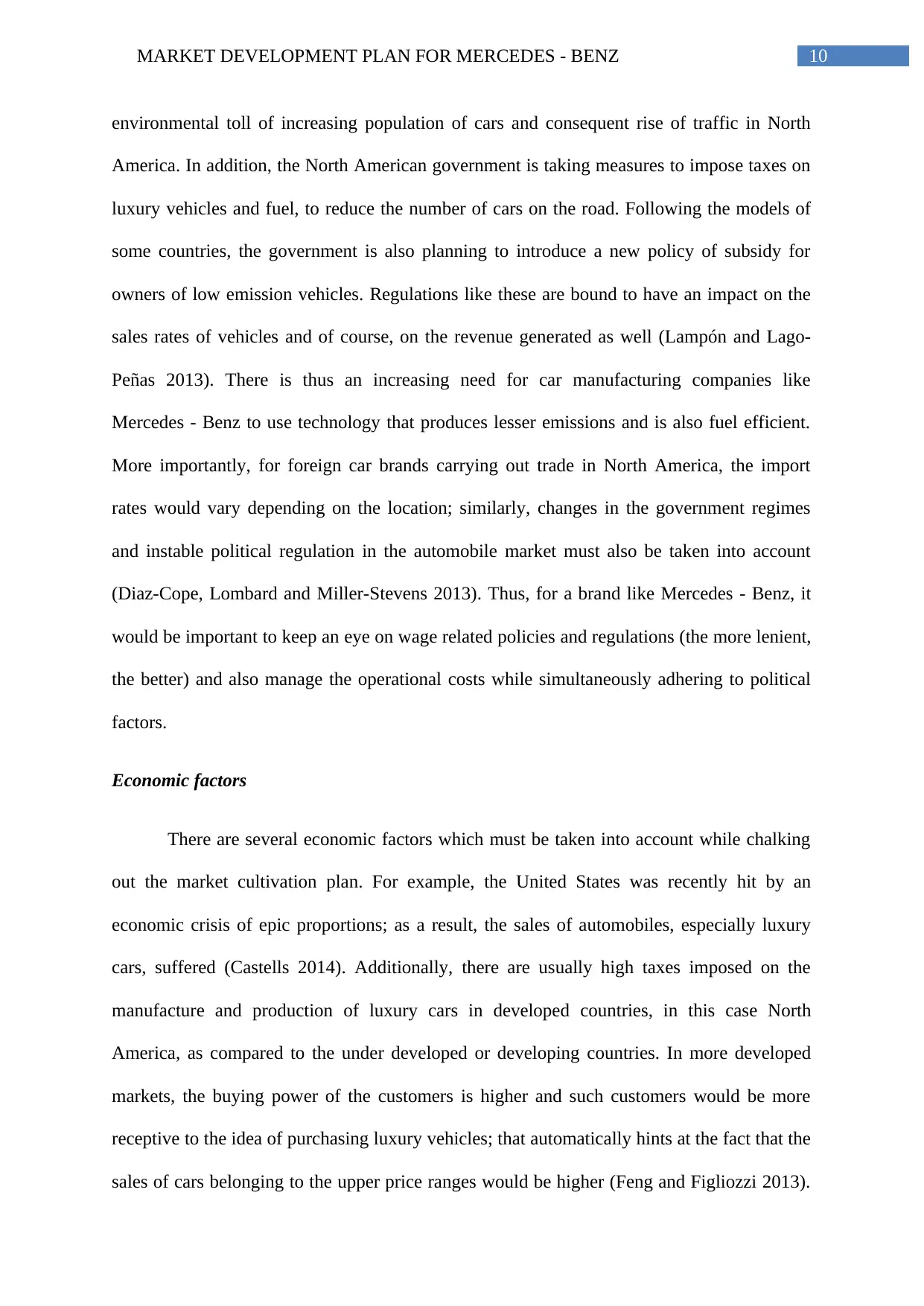
10MARKET DEVELOPMENT PLAN FOR MERCEDES - BENZ
environmental toll of increasing population of cars and consequent rise of traffic in North
America. In addition, the North American government is taking measures to impose taxes on
luxury vehicles and fuel, to reduce the number of cars on the road. Following the models of
some countries, the government is also planning to introduce a new policy of subsidy for
owners of low emission vehicles. Regulations like these are bound to have an impact on the
sales rates of vehicles and of course, on the revenue generated as well (Lampón and Lago-
Peñas 2013). There is thus an increasing need for car manufacturing companies like
Mercedes - Benz to use technology that produces lesser emissions and is also fuel efficient.
More importantly, for foreign car brands carrying out trade in North America, the import
rates would vary depending on the location; similarly, changes in the government regimes
and instable political regulation in the automobile market must also be taken into account
(Diaz-Cope, Lombard and Miller-Stevens 2013). Thus, for a brand like Mercedes - Benz, it
would be important to keep an eye on wage related policies and regulations (the more lenient,
the better) and also manage the operational costs while simultaneously adhering to political
factors.
Economic factors
There are several economic factors which must be taken into account while chalking
out the market cultivation plan. For example, the United States was recently hit by an
economic crisis of epic proportions; as a result, the sales of automobiles, especially luxury
cars, suffered (Castells 2014). Additionally, there are usually high taxes imposed on the
manufacture and production of luxury cars in developed countries, in this case North
America, as compared to the under developed or developing countries. In more developed
markets, the buying power of the customers is higher and such customers would be more
receptive to the idea of purchasing luxury vehicles; that automatically hints at the fact that the
sales of cars belonging to the upper price ranges would be higher (Feng and Figliozzi 2013).
environmental toll of increasing population of cars and consequent rise of traffic in North
America. In addition, the North American government is taking measures to impose taxes on
luxury vehicles and fuel, to reduce the number of cars on the road. Following the models of
some countries, the government is also planning to introduce a new policy of subsidy for
owners of low emission vehicles. Regulations like these are bound to have an impact on the
sales rates of vehicles and of course, on the revenue generated as well (Lampón and Lago-
Peñas 2013). There is thus an increasing need for car manufacturing companies like
Mercedes - Benz to use technology that produces lesser emissions and is also fuel efficient.
More importantly, for foreign car brands carrying out trade in North America, the import
rates would vary depending on the location; similarly, changes in the government regimes
and instable political regulation in the automobile market must also be taken into account
(Diaz-Cope, Lombard and Miller-Stevens 2013). Thus, for a brand like Mercedes - Benz, it
would be important to keep an eye on wage related policies and regulations (the more lenient,
the better) and also manage the operational costs while simultaneously adhering to political
factors.
Economic factors
There are several economic factors which must be taken into account while chalking
out the market cultivation plan. For example, the United States was recently hit by an
economic crisis of epic proportions; as a result, the sales of automobiles, especially luxury
cars, suffered (Castells 2014). Additionally, there are usually high taxes imposed on the
manufacture and production of luxury cars in developed countries, in this case North
America, as compared to the under developed or developing countries. In more developed
markets, the buying power of the customers is higher and such customers would be more
receptive to the idea of purchasing luxury vehicles; that automatically hints at the fact that the
sales of cars belonging to the upper price ranges would be higher (Feng and Figliozzi 2013).
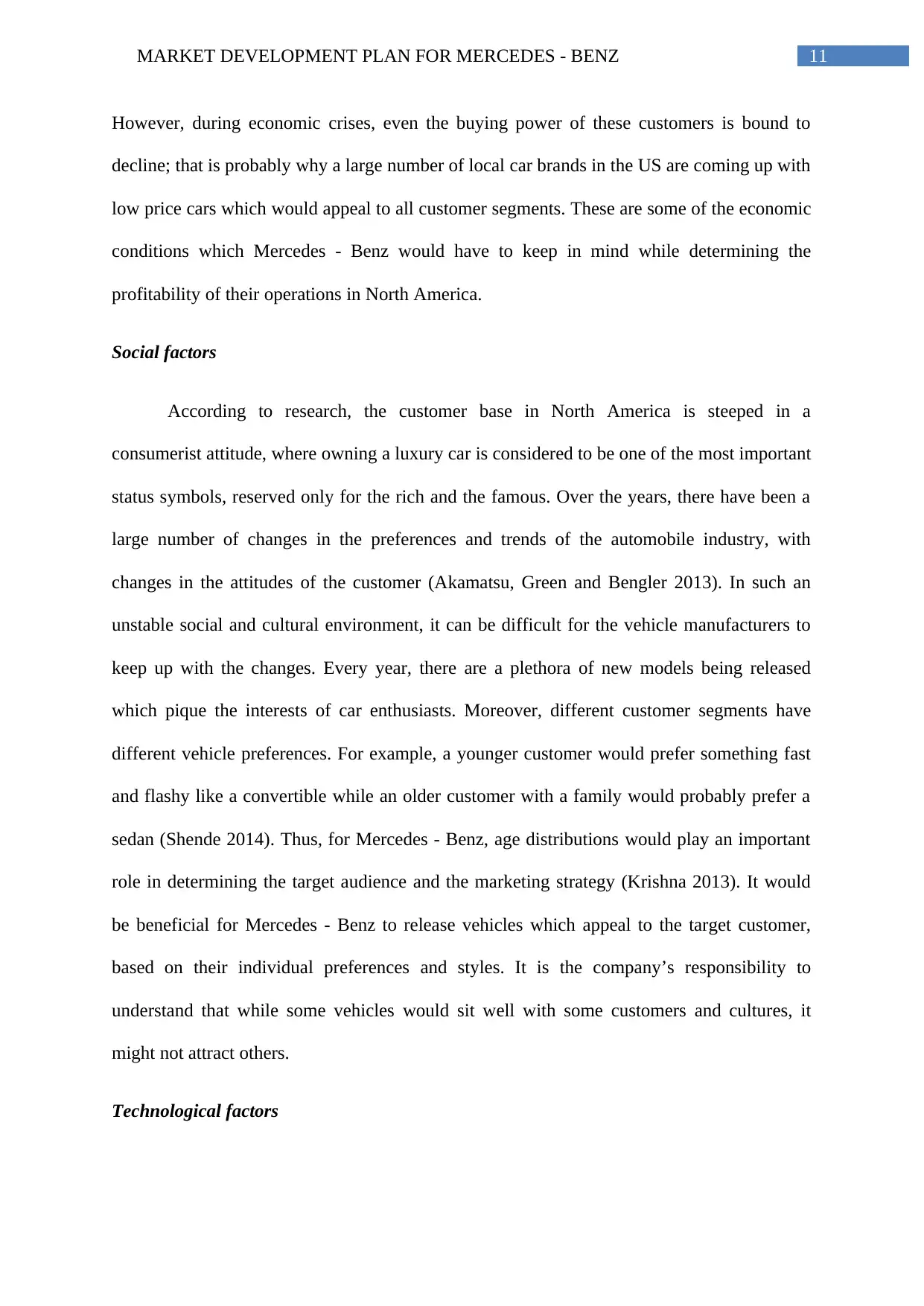
11MARKET DEVELOPMENT PLAN FOR MERCEDES - BENZ
However, during economic crises, even the buying power of these customers is bound to
decline; that is probably why a large number of local car brands in the US are coming up with
low price cars which would appeal to all customer segments. These are some of the economic
conditions which Mercedes - Benz would have to keep in mind while determining the
profitability of their operations in North America.
Social factors
According to research, the customer base in North America is steeped in a
consumerist attitude, where owning a luxury car is considered to be one of the most important
status symbols, reserved only for the rich and the famous. Over the years, there have been a
large number of changes in the preferences and trends of the automobile industry, with
changes in the attitudes of the customer (Akamatsu, Green and Bengler 2013). In such an
unstable social and cultural environment, it can be difficult for the vehicle manufacturers to
keep up with the changes. Every year, there are a plethora of new models being released
which pique the interests of car enthusiasts. Moreover, different customer segments have
different vehicle preferences. For example, a younger customer would prefer something fast
and flashy like a convertible while an older customer with a family would probably prefer a
sedan (Shende 2014). Thus, for Mercedes - Benz, age distributions would play an important
role in determining the target audience and the marketing strategy (Krishna 2013). It would
be beneficial for Mercedes - Benz to release vehicles which appeal to the target customer,
based on their individual preferences and styles. It is the company’s responsibility to
understand that while some vehicles would sit well with some customers and cultures, it
might not attract others.
Technological factors
However, during economic crises, even the buying power of these customers is bound to
decline; that is probably why a large number of local car brands in the US are coming up with
low price cars which would appeal to all customer segments. These are some of the economic
conditions which Mercedes - Benz would have to keep in mind while determining the
profitability of their operations in North America.
Social factors
According to research, the customer base in North America is steeped in a
consumerist attitude, where owning a luxury car is considered to be one of the most important
status symbols, reserved only for the rich and the famous. Over the years, there have been a
large number of changes in the preferences and trends of the automobile industry, with
changes in the attitudes of the customer (Akamatsu, Green and Bengler 2013). In such an
unstable social and cultural environment, it can be difficult for the vehicle manufacturers to
keep up with the changes. Every year, there are a plethora of new models being released
which pique the interests of car enthusiasts. Moreover, different customer segments have
different vehicle preferences. For example, a younger customer would prefer something fast
and flashy like a convertible while an older customer with a family would probably prefer a
sedan (Shende 2014). Thus, for Mercedes - Benz, age distributions would play an important
role in determining the target audience and the marketing strategy (Krishna 2013). It would
be beneficial for Mercedes - Benz to release vehicles which appeal to the target customer,
based on their individual preferences and styles. It is the company’s responsibility to
understand that while some vehicles would sit well with some customers and cultures, it
might not attract others.
Technological factors
⊘ This is a preview!⊘
Do you want full access?
Subscribe today to unlock all pages.

Trusted by 1+ million students worldwide
1 out of 31
Related Documents
Your All-in-One AI-Powered Toolkit for Academic Success.
+13062052269
info@desklib.com
Available 24*7 on WhatsApp / Email
![[object Object]](/_next/static/media/star-bottom.7253800d.svg)
Unlock your academic potential
Copyright © 2020–2025 A2Z Services. All Rights Reserved. Developed and managed by ZUCOL.




